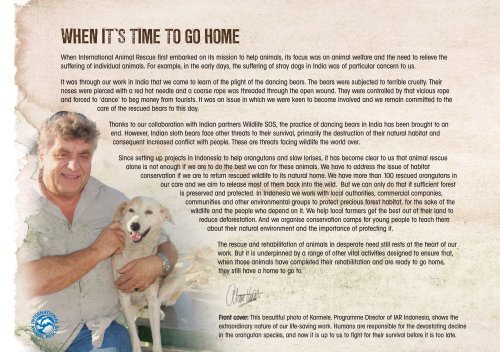7738 IAR rescuer leaflet 18 hr 148x210 16pp HR
Create successful ePaper yourself
Turn your PDF publications into a flip-book with our unique Google optimized e-Paper software.
<strong>IAR</strong> <strong>rescuer</strong> <strong>leaflet</strong> <strong>18</strong>.qxp_Layout 1 01/08/20<strong>18</strong> 10:20 Page 2<br />
WHEN IT’S TIME TO GO HOME<br />
When International Animal Rescue first embarked on its mission to help animals, its focus was on animal welfare and the need to relieve the<br />
suffering of individual animals. For example, in the early days, the suffering of stray dogs in India was of particular concern to us.<br />
It was t<strong>hr</strong>ough our work in India that we came to learn of the plight of the dancing bears. The bears were subjected to terrible cruelty. Their<br />
noses were pierced with a red hot needle and a coarse rope was t<strong>hr</strong>eaded t<strong>hr</strong>ough the open wound. They were controlled by that vicious rope<br />
and forced to ‘dance’ to beg money from tourists. It was an issue in which we were keen to become involved and we remain committed to the<br />
care of the rescued bears to this day.<br />
Thanks to our collaboration with Indian partners Wildlife SOS, the practice of dancing bears in India has been brought to an<br />
end. However, Indian sloth bears face other t<strong>hr</strong>eats to their survival, primarily the destruction of their natural habitat and<br />
consequent increased conflict with people. These are t<strong>hr</strong>eats facing wildlife the world over.<br />
Since setting up projects in Indonesia to help orangutans and slow lorises, it has become clear to us that animal rescue<br />
alone is not enough if we are to do the best we can for these animals. We have to address the issue of habitat<br />
conservation if we are to return rescued wildlife to its natural home. We have more than 100 rescued orangutans in<br />
our care and we aim to release most of them back into the wild. But we can only do that if sufficient forest<br />
is preserved and protected. In Indonesia we work with local authorities, commercial companies,<br />
communities and other environmental groups to protect precious forest habitat, for the sake of the<br />
wildlife and the people who depend on it. We help local farmers get the best out of their land to<br />
reduce deforestation. And we organise conservation camps for young people to teach them<br />
about their natural environment and the importance of protecting it.<br />
The rescue and rehabilitation of animals in desperate need still rests at the heart of our<br />
work. But it is underpinned by a range of other vital activities designed to ensure that,<br />
when those animals have completed their rehabilitation and are ready to go home,<br />
they still have a home to go to.<br />
Front cover: This beautiful photo of Karmele, Programme Director of <strong>IAR</strong> Indonesia, shows the<br />
extraordinary nature of our life-saving work. Humans are responsible for the devastating decline<br />
in the orangutan species, and now it is up to us to fight for their survival before it is too late.


